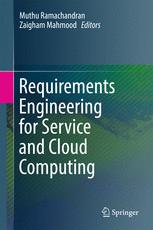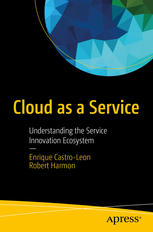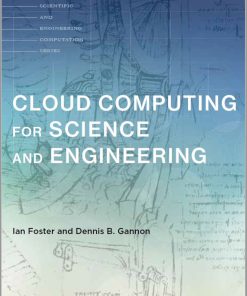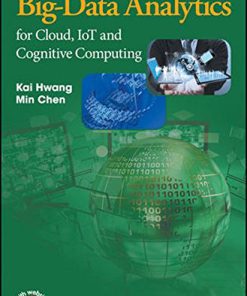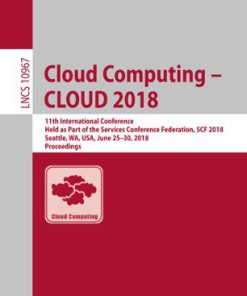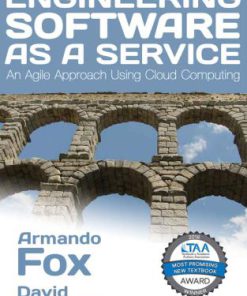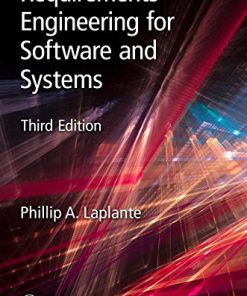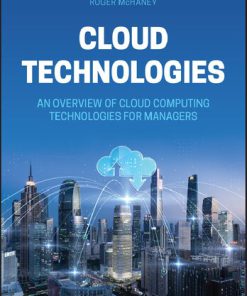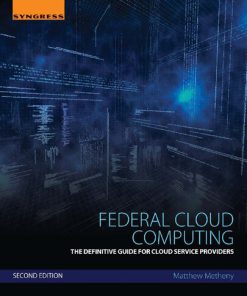Requirements Engineering for Service and Cloud Computing 1st Edition by Muthu Ramachandran, Zaigham Mahmood ISBN 3319513109 9783319513102
$50.00 Original price was: $50.00.$25.00Current price is: $25.00.
Requirements Engineering for Service and Cloud Computing 1st Edition by Muthu Ramachandran, Zaigham Mahmood – Ebook PDF Instant Download/Delivery: 3319513109, 9783319513102
Full download Requirements Engineering for Service and Cloud Computing 1st Edition after payment
Product details:
ISBN 10: 3319513109
ISBN 13: 9783319513102
Author: Muthu Ramachandran, Zaigham Mahmood
This authoritative text/reference describes the state of the art in requirements engineering for software systems for distributed computing. A particular focus is placed on integrated solutions, which take into account the requirements of scalability, flexibility, sustainability and operability for distributed environments. Topics and features: discusses the latest developments, tools, technologies and trends in software requirements engineering; reviews the relevant theoretical frameworks, practical approaches and methodologies for service requirements; examines the three key components of the requirements engineering process, namely requirements elicitation, requirements specification, and requirements validation and evaluation; presents detailed contributions from an international selection of highly reputed experts in the field; offers guidance on best practices, and suggests directions for further research in the area.
Requirements Engineering for Service and Cloud Computing 1st Table of contents:
1 What We Say We Want and What We Really Need: Experiences on the Barriers to Communicate Informatio
Abstract
1.1 Introduction
1.2 The Challenging Role of the Requirements
1.3 What We Say We Want and Why
1.4 What We Truly Need
1.4.1 Problems of Scope
1.4.2 Problems of Volatility
1.4.3 Problems of Observed Quality
1.4.4 Problems of Expected Quality
1.4.5 Problems of Quantity
1.5 Barriers to Communication
1.5.1 Barriers at the Customer Interface
1.5.2 Internal Barriers
1.5.3 Human Barriers
1.6 Requirements and Architecture
1.7 Guidelines for the Transformation
1.8 Conclusions
References
2 Cloud Dimensions for Requirements Specification
Abstract
2.1 Introduction
2.2 Background
2.3 Cloud Dimensions, Requirements, and Capabilities
2.3.1 Contractual Dimension
2.3.2 Financial Dimension
2.3.3 Compliance Dimension
2.3.4 Operational Dimension
2.3.5 Technical Dimension
2.4 Sample Scenario: The Security Guard Company
2.5 Conclusions
References
3 Analyzing Requirements Engineering for Cloud Computing
Abstract
3.1 Introduction
3.2 Background
3.3 Literature Review
3.4 Discussions
3.5 Sample Scenario: Sales Company
3.6 Conclusions
References
4 Classification of Non-functional Requirements of Web Services from Multiperspective View
Abstract
4.1 Introduction
4.2 Literature Review
4.3 Comparison of Various QoS Models
4.4 PCB-QoS Classification
4.4.1 Perspectives of PCB-QoS Classification
4.4.2 PCB-QoS Parameters
4.4.3 Monitoring and Evaluation Algorithm for PCB-QoS Parameters
4.5 ARSM Approach
4.5.1 Scaling QoS Parameters Value
4.5.2 Assigning Default Priority Constraints
4.5.3 Computation of OQS
4.6 Implementation
4.7 Experimental Evaluation
4.8 Summary
References
5 The Requirements Elicitation Approaches for Software-Defined Cloud Environments
Abstract
5.1 Recollecting the Requirements Engineering Process
5.2 The Literature Survey
5.3 Reflecting the Cloud Journey
5.4 Elucidating the Cloudification Process
5.5 The IT Commoditization and Compartmentalization
5.6 The Emergence of Software-Defined Infrastructures (SDI)
5.7 The Major Building Blocks of Software-Defined Clouds (SDCs)
5.8 Network Functions Virtualization (NFV)
5.9 Accentuating Software-Defined Storage (SDS)
5.10 The Key Benefits of Software-Defined Clouds (SDCs)
5.11 The Requirements Gathering Steps for Software-Defined Clouds
5.12 Integration Requirements
5.13 Conclusion
References
Requirements Specification for Service and Cloud Computing
6 Formal Modeling of Enterprise Cloud Bus System: A High Level Petri-Net Based Approach
Abstract
6.1 Introduction
6.2 Related Research
6.3 Multi-agent Based Inter-cloud Architecture (ECBS)
6.3.1 Building Blocks of ECBS
6.3.2 Formalization of ECBS
6.3.3 Conceptualization of ECBS in MAS Architecture
6.3.4 Structural Analysis of ECBS
6.3.5 ECBS Elements in MAS Architecture
6.4 High-Level Enterprise Cloud Bus Petri-Net (HECBP)
6.4.1 Definition: High-Level Enterprise Cloud Bus Petri-Net (HECBP)
6.4.2 HECBP Elements: Places and Transitions
6.5 Analysis of ECBS Based on HECBP
6.5.1 HECBP-Based Analysis of ECBS
6.5.2 Simulation of HECBP
6.5.3 HECBP Simulation Through CPN Tool
6.5.4 State Space Analysis
6.6 Future Research Directions
6.7 Conclusion
References
Additional References
7 Requirements to Services: A Model to Automate Service Discovery and Dynamic Choreography from Serv
Abstract
7.1 Introduction
7.2 Review of Literature
7.2.1 Requirement Formalization
7.2.2 Service Versioning and Dynamic Service Discovery
7.2.3 Traceability of Requirements
7.3 Scope of Work
7.4 Requirement Parser and Analyzer
7.4.1 Requirement Classification
7.4.2 Context-Free Grammar
7.4.3 Requirement Parser
7.4.4 Model Generator: Generation of Activity Model for a Requirement Scenario
7.5 Activity Model to BPMN Transformation
7.5.1 Transformation Rules
7.5.2 Algorithm NodeGeneration to Generate BPMN Node
7.5.3 Algorithm FlowGeneration to Generate the Flow Between BPMN Nodes
7.6 Service Version Discovery Based on BPMN Model
7.6.1 Service Version Database (SVD)—ER Mapping
7.6.2 Discovery of Services from ESB Based on SVD
7.7 Service Version Discovery Based on BPMN Model
7.7.1 Traceability Graph (TG)
7.7.2 Traceability Rules
7.7.3 R2S: Traceability from Requirements to Services
7.8 Conclusion
References
8 Architecturally Significant Requirements Identification, Classification and Change Management for
Abstract
8.1 Introduction
8.2 Architecturally Significant Requirements of the Cloud-Based Systems
8.2.1 Scalability
8.2.2 Elasticity
8.2.3 Availability
8.2.4 Security
8.2.5 Privacy
8.2.6 Interoperability
8.2.7 Service Level Agreement (SLA) Compliance
8.3 Relationship of the Architecturally Significant Requirements with Multi-tenancy Quality Characte
8.4 A Classification Scheme for Management of Architecturally Significant Requirements
8.4.1 System Management Requirements for Hosted Services and Data
8.4.1.1 Quality Specific Provisioning
8.4.1.2 Interoperability and Integration Requirements
8.4.1.3 Security and Privacy Requirements
8.4.2 Communication and Collaboration Requirements
8.4.3 Monitoring Requirements
8.5 A Probabilistic Analysis Method to Analyze Impact of Changes in Architecturally Significant Requ
8.6 Related Work
8.7 Conclusions
Acknowledgements
References
Requirements Validation, Evaluation, and QoS for Service and Cloud Computing
9 Cyber Security Requirements Engineering
Abstract
9.1 Introduction
9.2 Cyber Security Requirements
9.3 Risk-Oriented Security
9.4 Industry Case Study
9.5 Security Requirements Elicitation
9.6 Security Analysis
9.6.1 Threat Analysis
9.6.2 Risk Assessment
9.7 Security Design
9.7.1 Security Functionality with Minimal Resource Impact
9.7.2 Composition of the Layers
9.7.3 Implementing Security Functionality
9.8 Security Validation
9.9 Relevance and Outlook
References
10 Appraisal and Analysis of Various Self-Adaptive Web Service Composition Approaches
Abstract
10.1 Introduction
10.2 Self-Adaptive WSC
10.3 RE for Self-Adaptive Systems
10.4 Requirements Specification Models in WSC
10.5 Classification of Self-Adaptive WSC Approaches
10.5.1 Used of Variability Models
10.5.1.1 Architecture Level
10.5.1.2 Implementation Level
10.5.2 Context-Awareness
10.5.3 Multi-Agent Approaches
10.6 Comparison and Limitations of Self-Adaptive WSC Approaches
10.7 Conclusion and Future Work
References
11 Transition from Information Systems to Service-Oriented Logical Architectures: Formalizing Steps
Abstract
11.1 Introduction
11.2 The V+V Model
11.3 Steps and QVT Rules for Transition Between V-Models
11.4 Demonstration Case on the Transition Process
11.5 Comparison with Related Work
11.6 Conclusions
References
12 Improving the QoS of a Composite Web Service by Pruning its Weak Partners
Abstract
12.1 Introduction
12.2 Problem Definition
12.2.1 Motivating Example
12.3 Related Work
12.4 Research Methodology
12.4.1 The Statistics
12.4.2 Identifying the Outlier(s)
12.4.3 Analyze the Influence of the Outlier
12.5 Results and Analysis
12.5.1 Experiment 1
12.6 Effectiveness
12.7 Efficiency
12.8 Quality of the Solution
12.8.1 Experiment 2
12.9 Quality of the Solution
12.10 Efficiency
12.11 Scalability
12.12 Limitations of the Study
12.13 Conclusions
References
13 Using Distributed Agile Patterns for Supporting the Requirements Engineering Process
Abstract
13.1 Introduction
13.2 Agile Offshore Software Development
13.3 Challenges in Requirements Engineering Process in Agile Offshore Development
13.4 Distributed Agile Patterns
13.5 Distributed Agile Patterns Used for Requirements Engineering Process
13.5.1 Project Charter Pattern
13.5.2 Collective Project Planning Pattern
13.5.3 Local Sprint Planning Meeting Pattern
13.5.4 Collaborative Planning Poker Pattern
13.5.5 Global Scrum Board Pattern
13.5.6 Central Code Repository Pattern
13.5.7 Asynchronous Information Transfer Pattern
13.5.8 Synchronous Communication Pattern
13.5.9 Visit Onshore–Offshore Team Pattern
13.6 Use of Distributed Agile Patterns in Requirements Engineering Process in Agile Offshore Develop
13.7 Mapping Distributed Agile Patterns on the Requirements Engineering Lifecycle
13.8 Conclusions
People also search for Requirements Engineering for Service and Cloud Computing 1st:
requirements engineering for service and cloud computing
requirements for cloud engineer
cloud computing engineer requirements
requirements to become a cloud engineer
cloud engineering requirements
Tags:
Muthu Ramachandran,Zaigham Mahmood,Requirements Engineering,Service,Cloud Computing
You may also like…
Computers - Hardware
Cloud as a Service Understanding the Service Innovation Ecosystem 1st Edition Enrique Castro-Leon
Computers - Programming
Cloud Computing for Science and Engineering 1st Edition Ian Foster
Computers - Networking
Computers - Programming
Requirements Engineering for Software and Systems 3rd Edition Phillip A. Laplante
Computers - Organization and Data Processing
Computers - Programming
Federal Cloud Computing The Definitive Guide for Cloud Service Providers 2nd Edition Matthew Metheny


